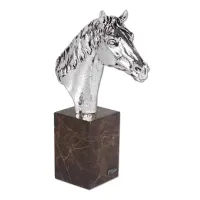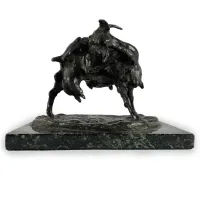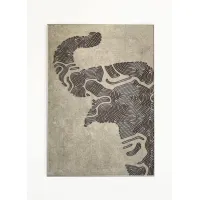A tasteful goat sculpture from the 20th century
Luxury antiques
SKU: ANT-A1400
See other products from category Animal sculptures or from manufacturer Antyki with shipping within 24 hours
Description
Goat by Ernesto Bazzaro in bronze – a sculpture by Ernesto Bazzaro, an important Lombard sculptor and engraver active at the end of the 19th and beginning of the 20th century. Bazzaro (Milan 1859-1937) was known for his innovative approach to sculpture, characterized by dynamic realism and great attention to detail, often with a touch of expressionism, which gave his sculptures an almost impressionistic character. His works include portraits and scenes from everyday life, with a particular focus on the depiction of movement and emotion.
Bazzaro's signature engraved in italics on the contoured bronze base confirms the authenticity of the work. The bronze casting itself measures 15.5 cm in height x 21 x 13, with the dimensions also referring to the base. The rectangular marble base, 2 cm high, on which the bronze sculpture rests, is an important detail, as marble is often used in combination with bronze to achieve a refined visual effect and provide stability to the piece.
The work has a beautiful bronze patina and is in good condition, which enhances its value, making it a valuable exhibit for collectors of antique sculptures and enthusiasts of early 20th-century art. Bazzaro as a sculptor left a significant mark on Italian art of the time, and works of this type are highly valued for their technical quality and historical value.
Beautiful antique furniture and accessories can be an excellent idea for decorating our interiors. Today, there are more and more enthusiasts of high-quality old products that have a specific character and soul. It's a nod to the history, creation, and design of traditional and timeless furniture. There are many different styles in antique furniture, each with its distinctive features.
There are many different styles characterizing antique furniture, but we can distinguish a few of the most important ones. Eclectic furniture belongs to the 19th century, during which the Biedermeier style reigned. Its variations in the early years of this century include neo-Gothic, Gothic, Rococo, Louis Philippe style, and finally the English Victorian style. By the end of the century, these styles transition into pseudo-styles of classicism, Renaissance, and Baroque.
Original Empire-style furniture dates from the period between the late 18th and early 19th centuries. It all stems from the reign of Napoleon. There, a significant resemblance and references to Roman and Greek decorations were imposed.
Classicist furniture is the Louis XVI style, which also strongly references ancient architecture. Interesting and noteworthy are all antique products in the Rococo and Louis XV styles. Next is Baroque, whose name comes from the Portuguese barocco – which translates to an irregularly developed pearl. These were very representative pieces of furniture, meant to literally drip with glamour and play a significant role in luxury. Exceptional, selectively used materials were employed to further emphasize the lofty tone of these products.
Today we can observe how much influence the Baroque style had on today's classic furniture, which is designed with great similarity to the past era. Another significant style is the Renaissance, which flourished in the 15th and 16th centuries and also left a significant mark on the art of furniture making. The Renaissance style was quite heavy and massive. Brown stains were used, as well as cornices, strong plinths, and bas-reliefs. It can certainly be said that these were quite specific products, but they provided many new possibilities such as the construction of the sideboard or generally broadly defined chest furniture. Here, too, there was an interest in mythology and ancient times, so supports or legs took on animal forms.
Lion's paws, eagle heads – this is a common sight in the Renaissance style. Currently, many global brands recreate such furniture, taking examples from Italian or French creators. It's a manifestation of admiration and care for the history of the most beautiful Renaissance antiques. It is important to remember that in each country, furniture manufacturing was perceived differently, so each style in a given country had its own distinct character. This is very important, especially when searching for the right luxury antique for your interior.
The most important aspect of stylish antique furniture is originality. This is ultimately crucial from the customer's perspective, as there are many counterfeits circulating in the market. The Luxury Products brand provides a document confirming the product's compliance with the actual description and photo. At your disposal, we have art appraisers, historians, and experts from around the world.
Attributes / Details
| SKU | ANT-A1400 |
| Manufacturer | Antyki |
| Model | A1400 |
| Material | brown |
| Size | Height: 17.5 cm Width: 23.5 cm Depth: 15.5 cm |
| Wiek | XX |
| Rok | 1900 |
| Destiny | To home |
See catalog
Reviews
No reviews for this product.













